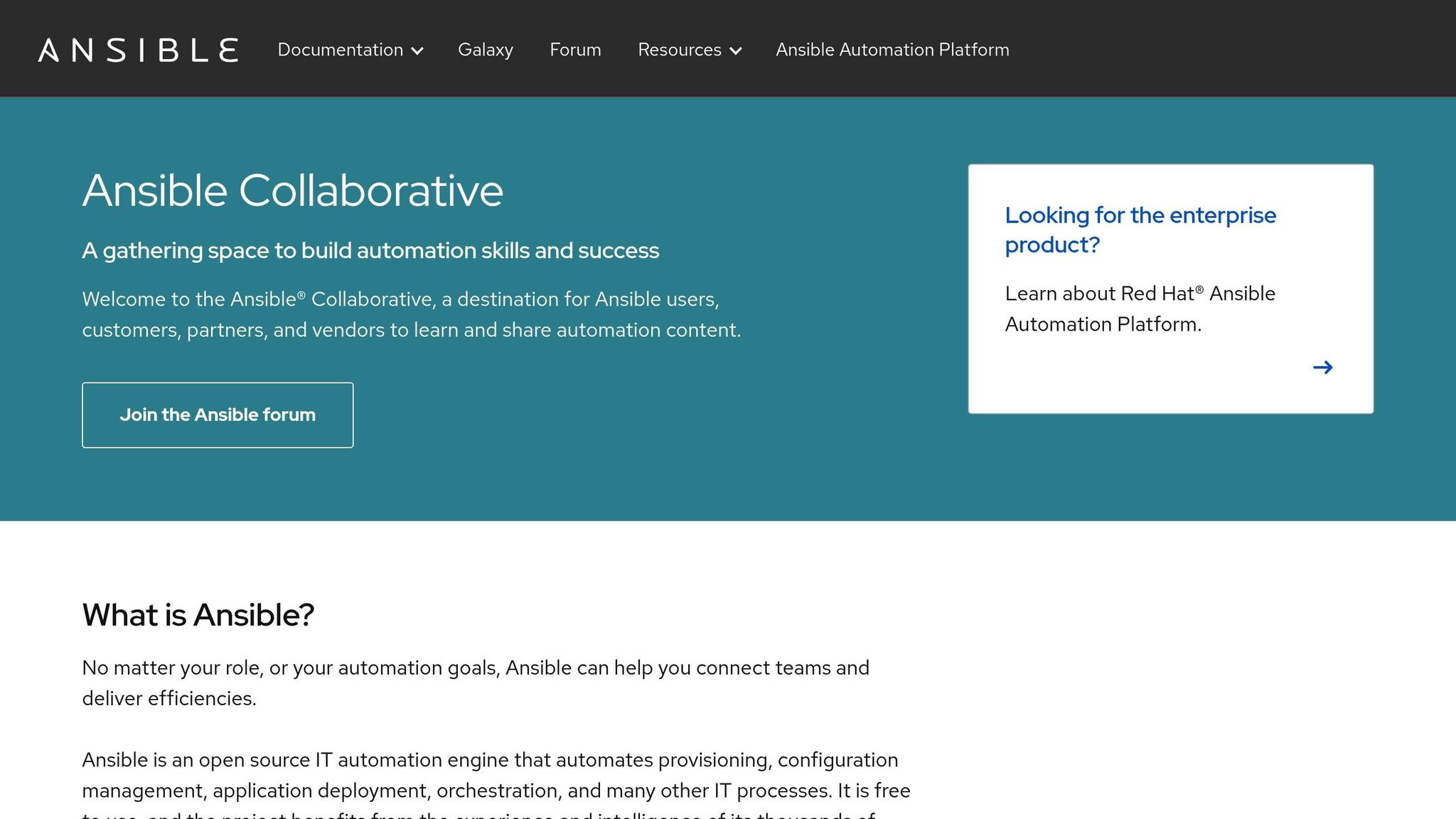Workflow automation for IT infrastructure simplifies repetitive tasks like server provisioning, software updates, and system monitoring. This is a game-changer for small and medium-sized enterprises (SMEs), enabling them to save time, reduce errors, and focus on growth. Here's what you need to know:
- What It Is: Automation uses technology to execute tasks based on preset rules and triggers, such as scaling resources when server usage spikes.
- Why SMEs Need It: Small IT teams face resource constraints, higher risks of errors, and inefficiencies. Automation reduces these challenges, improves reliability, and keeps costs predictable.
- AI's Role: AI-powered tools enhance automation by predicting issues, analyzing data, and continuously improving workflows.
- Core Features: Includes hardware/software provisioning, network/data center management, cloud integration, and cybersecurity.
- Top Tools: Options like Microsoft Power Automate, Zapier, Ansible, and ServiceNow offer tailored solutions for SMEs.
- Implementation Tips: Start small, map workflows, test, and expand gradually. Train your team to handle automated systems effectively.
- Scalability & Security: Design workflows for growth, monitor performance, and prioritize security with encryption, access controls, and regular updates.
Learn Infrastructure Automation in 15 Minutes | Automate Ansible Playbooks at Scale with Kestra

Core Components of IT Infrastructure Automation
For small and medium-sized enterprises (SMEs), understanding the essential elements of IT infrastructure automation is crucial. Each automated component not only reduces the strain on resources but also enhances reliability and efficiency across operations.
Hardware and Software Automation
Hardware provisioning leverages templates and scripts to deploy hardware in minutes instead of hours. For example, when additional server capacity is needed, automated systems can instantly spin up virtual machines, configure storage, and establish network connections. Similarly, software deployment automation ensures updates and applications are pushed across systems simultaneously, maintaining consistency and eliminating the need for manual installations.
Configuration management tools simplify processes like patch management by scheduling updates during off-peak hours. These tools test patches in staging environments before rolling them out gradually to production systems. Automated provisioning ensures that every deployment uses the same configurations, keeping infrastructure standardized and predictable.
These efficiencies extend further with automation solutions for networks and data centers.
Network and Data Center Automation
Software-defined networking (SDN) centralizes network policy management, allowing configurations to be automatically distributed across the entire network. Load balancing becomes a seamless process as automated systems continuously monitor performance metrics and redirect traffic in real time, ensuring smooth operations without constant manual intervention.
Data center automation takes care of environmental controls, power management, and capacity planning. Automated systems monitor factors like temperature and humidity, adjusting cooling systems to reduce energy usage. Power management tools can shut down non-essential systems during periods of low demand and reactivate them as needed.
Capacity planning is also enhanced with automated monitoring tools that track resource usage trends and predict when additional capacity will be required, often weeks in advance. On the security front, network automation identifies unusual traffic patterns, isolates potentially compromised devices, and updates firewall rules to counter emerging threats.
With these optimizations in place, cloud integration and cybersecurity tools further strengthen IT operations.
Cloud Integration and Cybersecurity Tools
Cloud automation enables hybrid environments where workloads can shift between on-premises servers and cloud platforms based on factors like demand, cost, or performance. Multi-cloud management tools automate resource provisioning, cost tracking, and compliance enforcement across multiple platforms, ensuring flexibility and avoiding vendor lock-in.
Cybersecurity automation works around the clock to monitor network traffic, system logs, and user behaviors for potential threats. When suspicious activity is detected, automated systems isolate affected devices, block malicious traffic, and notify security teams. These tools ensure continuous business operations while keeping costs manageable.
Incident response automation takes this a step further by following predefined playbooks. It collects forensic data and initiates containment measures within seconds. Compliance automation adds another layer of protection by continuously monitoring configurations, generating reports, and flagging potential violations before they escalate.
Backup and disaster recovery automation ensures regular backups, tests recovery processes, and maintains secure off-site copies of critical data. In the event of a system failure, automated recovery processes restore operations quickly, minimizing downtime.
Platforms like AI for Businesses provide SMEs with access to advanced automation tools, integrating AI-driven capabilities into these core components. This allows businesses to benefit from predictive decision-making without requiring extensive technical expertise.
Best Workflow Automation Tools for SMEs
Picking the right tools can make or break an SME's IT infrastructure. With limited resources and operational hurdles, it’s important to invest in automation solutions that are both powerful and easy to use - without needing a full-fledged technical team.
Top Tools and Platforms
Microsoft Power Automate is a go-to for SMEs already using Microsoft 365. It integrates effortlessly with the suite, offering pre-built templates for tasks like user provisioning and system alerts. Its drag-and-drop interface is user-friendly, enabling non-technical staff to build workflows with ease.
Zapier simplifies connecting various software applications without requiring coding. With support for thousands of apps, Zapier automates repetitive tasks such as ticket creation and user onboarding, saving time and reducing manual errors.
Ansible is an open-source tool that excels in infrastructure automation. Using straightforward YAML playbooks, it handles server management, application deployment, and system updates. Many SMEs rely on its free community version for basic server-related tasks.
ServiceNow IT Operations Management delivers enterprise-level automation tailored for scaling businesses. It combines incident management, change tracking, and infrastructure monitoring. With AI-driven insights, it helps predict and prevent system issues before they disrupt operations.
Puppet Enterprise focuses on configuration management and compliance automation. It ensures systems stay consistent with security policies and provides detailed reporting for compliance audits, making it a trusted choice for SMEs aiming to maintain system integrity.
For SMEs looking for a more tailored selection, curated AI tools designed specifically for IT infrastructure can simplify the decision-making process.
AI for Businesses Directory Benefits
Finding the right AI-powered tools can feel daunting, especially for SMEs without dedicated research teams. That’s where AI for Businesses steps in. This platform offers a curated directory of AI tools aimed at improving business operations, including IT automation.
Some standout tools include Writesonic, which automates documentation creation, helping IT teams generate system manuals and process guides effortlessly. Stability.ai specializes in creating visual assets like network diagrams, while Looka makes it easy to design professional dashboards and monitoring interfaces, simplifying complex IT data.
What makes AI for Businesses useful is its focus on solutions that smaller businesses can adopt immediately. Instead of overwhelming users with endless options, it highlights tools with clear use cases, integration details, and pricing information.
- Basic Plan: Free access to a limited catalog.
- Pro Plan: $29/month for full access and priority support.
- Enterprise Plan: Custom pricing for advanced integrations and dedicated IT support.
For SMEs, this directory is a game-changer. It connects them to automation tools that improve system performance and resource management. By narrowing down proven solutions, AI for Businesses helps reduce risks, speed up implementation, and deliver faster results for automation efforts.
sbb-itb-bec6a7e
Implementation Strategies and Best Practices
Implementing workflow automation across IT infrastructure isn’t just about flipping a switch - it requires careful planning and execution. A structured approach minimizes wasted resources, reduces the risk of failure, and ensures a smoother adoption process with better long-term outcomes.
Step-by-Step Implementation Plan
Start with workflow mapping before diving into automation tools. Document every IT process, from onboarding to system monitoring. This creates a clear picture of your current operations, highlights inefficiencies, and sets realistic improvement goals.
Choose a pilot area to kick off your automation efforts. Pick a single, well-defined process that’s critical but won’t disrupt the business if issues arise. Tasks like server patching, backup verification, or help desk ticket routing are ideal. These processes are repetitive, measurable, and have clear success metrics.
Run a pilot test on a small group of systems or users. Monitor the results closely for at least two weeks, tracking metrics such as time savings, error reduction, and user satisfaction. Document any challenges and how they were resolved to refine your approach.
Expand automation gradually in clearly defined phases. Roll out to additional systems and processes step by step, setting specific timelines and success benchmarks for each phase. This controlled growth allows you to identify and address issues early without overwhelming your team.
Continuously monitor and optimize throughout the rollout. Use dashboards to track performance, system health, and user feedback. Schedule regular reviews to pinpoint improvement areas and resolve emerging issues. Automation isn’t a “set it and forget it” solution - it requires ongoing fine-tuning to deliver consistent value.
At every stage, validate your progress and ensure your team is ready to adapt through training and change management.
Training and Change Management
Even with a successful rollout, team readiness is essential for long-term success. Involve your team early in the planning phase to reduce resistance. Many IT professionals worry that automation might replace their jobs or make their skills irrelevant. Address these concerns by explaining how automation will handle routine tasks, freeing them to focus on strategic projects, problem-solving, and innovation. Share examples of how their roles will evolve and grow.
Offer hands-on training for everyone who will interact with the automated systems. Go beyond documentation - provide practice opportunities in non-production environments. Regular training sessions should cover new features, troubleshooting tips, and best practices.
Develop automation champions within your team. Identify early adopters who are enthusiastic about automation and can assist with training and troubleshooting. These champions act as internal advocates, easing the burden on management and boosting team confidence.
Establish clear procedures for managing automated workflows. Document when manual intervention is needed, how to troubleshoot common issues, and who to contact for support. Set up escalation paths for problems that automation can’t resolve. This clarity ensures your team knows exactly how to operate within the automated environment.
Celebrate and communicate successes regularly. Share metrics that highlight time saved, error reductions, and system reliability improvements. Recognize both major milestones and smaller wins to keep the team motivated and engaged. Regular updates reinforce the value of automation and maintain momentum.
Building an automation-friendly culture takes time and effort. Prioritize open communication, thorough training, and demonstrating benefits rather than enforcing changes through top-down mandates.
Scalability, Optimization, and Security for Automated IT Workflows
Once your automation workflows are up and running, the next challenge is ensuring they can grow, adapt, and remain secure over time. Here's how to approach scalability, fine-tune performance, and safeguard your automated systems.
Planning for Scalability
Scalability is about preparing your workflows to handle growth without breaking a sweat. Start by designing workflows with flexibility in mind. Modular setups allow you to add new processes, systems, or users without disrupting operations.
Consider cloud-based automation platforms to handle scaling effortlessly. These platforms adjust computing resources automatically based on demand, so you won’t need to predict future capacity or maintain physical infrastructure as your business grows.
Stay ahead of resource bottlenecks by monitoring system performance and setting alerts for when usage exceeds 80%. This proactive step helps you address issues before they escalate.
If your business plans to expand geographically, prepare workflows for distributed operations. This includes accounting for time zones, network latency, and data residency requirements, as well as ensuring compliance with local regulations.
Budget for scaling costs like additional licenses or cloud resources. Tracking the cost per automated transaction will help you understand how expenses evolve as your volume increases.
Stress-test your systems regularly to find weak points before they cause failures. Load and stress testing are especially important during peak business periods when workflows are under maximum pressure.
Continuous Optimization Methods
Keeping workflows running smoothly requires constant fine-tuning. Start by establishing performance baselines - measure processing times, error rates, and resource usage. These metrics help you spot inefficiencies and track improvements.
Analyze workflow performance monthly to identify trends. Look for signs of trouble, such as processes taking longer than usual, generating more errors, or consuming too many resources. Many automation tools offer built-in analytics to make this easier.
As your business evolves, update automation rules to align with current needs. Schedule quarterly reviews to ensure workflows stay relevant and effective.
Streamline redundant workflows that may have cropped up over time. Teams often create overlapping processes, which can lead to unnecessary complexity. Consolidating these workflows reduces waste and simplifies maintenance.
Work closely with your development team to optimize database queries and API calls. Inefficient operations in these areas can slow down workflows significantly.
For high-volume tasks, use intelligent routing and load balancing to spread processing across multiple servers or services. This approach improves both speed and reliability.
When testing workflow improvements, run A/B tests to compare the new version against the old one. This gives you clear data on whether the changes deliver better results.
Security Best Practices
Automation is only as strong as its security. Start by enforcing role-based access controls to limit who can create, modify, or execute workflows. Regularly review permissions to ensure they align with current roles and responsibilities.
Protect sensitive data with encryption - both during transmission and while stored. This includes credentials, customer details, and any proprietary information. Use industry-standard encryption protocols and secure your encryption keys.
Log and monitor automated actions for a clear audit trail. Tracking what happened, when, and by whom is essential for compliance and investigating issues.
Secure API endpoints and integrations with strong authentication methods like OAuth 2.0 or scoped API keys. This prevents unauthorized access to your systems.
To minimize the impact of potential breaches, segment your network to isolate automated systems from other parts of your infrastructure.
Keep your automation software up to date with the latest patches and versions. Test updates in a staging environment before rolling them out to production to balance security with stability.
Develop incident response plans specifically for automation-related security events. Have clear steps in place for isolating compromised workflows, assessing data exposure, and restoring operations. Practice these plans with tabletop exercises to ensure your team is ready.
Finally, monitor for unusual activity in your workflows. Set alerts for anomalies like processes running outside normal hours, unexpected data volumes, or unusual system access. These can be early signs of security issues.
For advanced threat detection and automated responses, tools like AI for Businesses can integrate seamlessly into your existing workflows. They provide enhanced security monitoring to keep your systems protected while maintaining operational efficiency.
Conclusion: Getting Started with IT Workflow Automation
IT workflow automation has become a game-changer for SMEs aiming to stay competitive and operate efficiently. By automating repetitive tasks, businesses not only save time but also reduce errors and improve overall productivity. Companies that take the leap into automation today position themselves ahead of those stuck in manual processes.
A great way to begin is by automating a single repetitive task - like server monitoring or backup verification. Test it, measure the impact, and then expand automation efforts step by step. This approach minimizes risks and builds confidence in integrating automation across your organization.
The financial rewards can be impressive too. Many SMEs see a strong return on investment quickly, thanks to lower labor costs, fewer mistakes, and better system reliability.
Pick tools that grow with you. Cloud-based platforms are a smart choice since they allow you to scale as your business evolves without requiring heavy infrastructure investments. Many of these platforms include AI-powered features that adapt to changing conditions and learn from your data, aligning with the idea of intelligent workflows mentioned earlier.
Don’t overlook security. As your workflows handle more sensitive data, it’s critical to incorporate access controls, encryption, and monitoring from the start. A proactive security strategy can save you from costly and damaging incidents down the line.
Getting your team on board is key. Involve your IT staff in choosing and implementing automation tools. When they experience how automation reduces routine tasks and enhances their roles, they’re more likely to support the transition. Offering training and support ensures they’re equipped with the skills needed to work seamlessly with automated systems.
While technology evolves quickly, sticking to a clear plan - setting objectives, choosing reliable tools, starting small, and continuously refining - can make all the difference. Businesses that follow this structured approach often outperform those that dive in without proper preparation.
For SMEs exploring automation solutions, platforms like AI for Businesses provide a curated selection of AI-powered tools tailored to growing operational needs. These resources can simplify the decision-making process, helping you find effective solutions without the overwhelm.
Every day spent hesitating on automation is a day your competitors gain an edge. Start small - choose one workflow to automate this month - and see how quickly the benefits start to roll in.
FAQs
What steps can small and medium-sized businesses (SMBs) take to successfully implement workflow automation in their IT infrastructure?
To get started with workflow automation, small and medium-sized businesses (SMBs) should begin by evaluating their current processes. Look for repetitive tasks and areas where inefficiencies slow things down - these are prime candidates for automation. Instead of diving in headfirst, start with a small pilot project. This allows you to test out automation tools and make necessary adjustments before scaling up across the entire organization.
Keep a close eye on performance metrics like task completion times and error rates. These numbers will show whether the automation is actually making a difference. Additionally, gathering input from your team is crucial. Their feedback can help fine-tune the system and address any hiccups along the way. By taking it step by step and relying on data to guide decisions, SMBs can adopt workflow automation in a way that boosts efficiency while keeping disruptions to a minimum.
What security risks should businesses watch for when automating IT workflows, and how can they address them?
Automating IT workflows comes with its share of security concerns, including data breaches, unauthorized access, supply chain vulnerabilities, and hard-coded credentials. These risks can leave sensitive information exposed or open the door to cyberattacks.
To address these challenges, businesses should focus on a few key strategies:
- Enforce strong access controls: Limit access to sensitive systems and data to only those who truly need it.
- Conduct regular security audits: Routine checks help identify and fix vulnerabilities before they can be exploited.
- Leverage AI-driven monitoring tools: These tools can identify and respond to threats as they happen, offering real-time protection.
Taking a phased approach to automation can also provide better oversight and help manage risks more effectively. By prioritizing these measures, companies can ensure a more secure and seamless transition to automated IT workflows.
How can AI improve workflow automation in IT infrastructure, and what advantages does it offer to SMEs?
AI simplifies workflow automation in IT infrastructure by taking over repetitive tasks such as system monitoring, maintenance, and troubleshooting. This approach improves efficiency while reducing human errors and cutting down operational expenses.
For small and medium-sized businesses (SMEs), AI-powered automation allows IT operations to scale effectively without requiring extensive technical teams or hefty initial investments. The benefits? Increased productivity, lower costs, and quicker innovation - all of which enable businesses to concentrate on growth and enhancing customer experiences.


